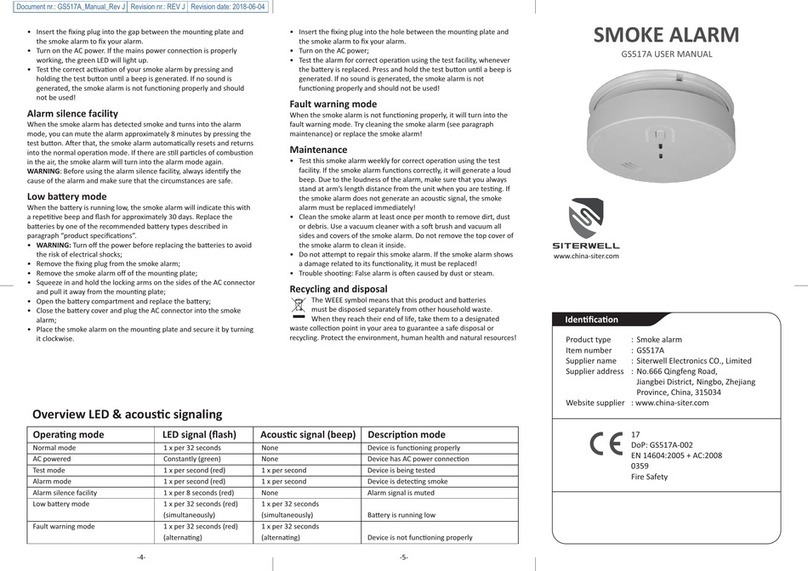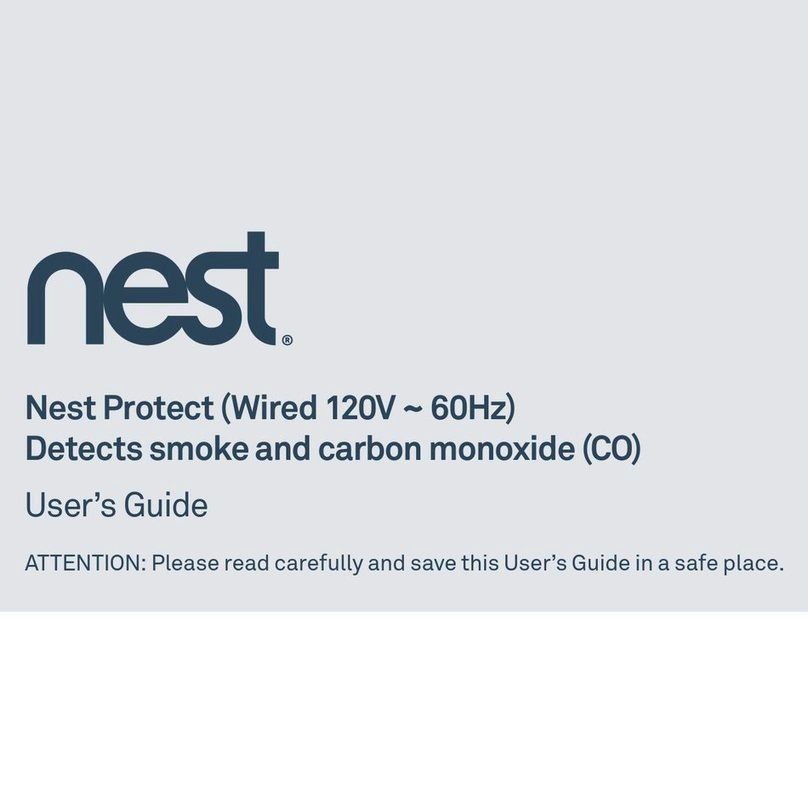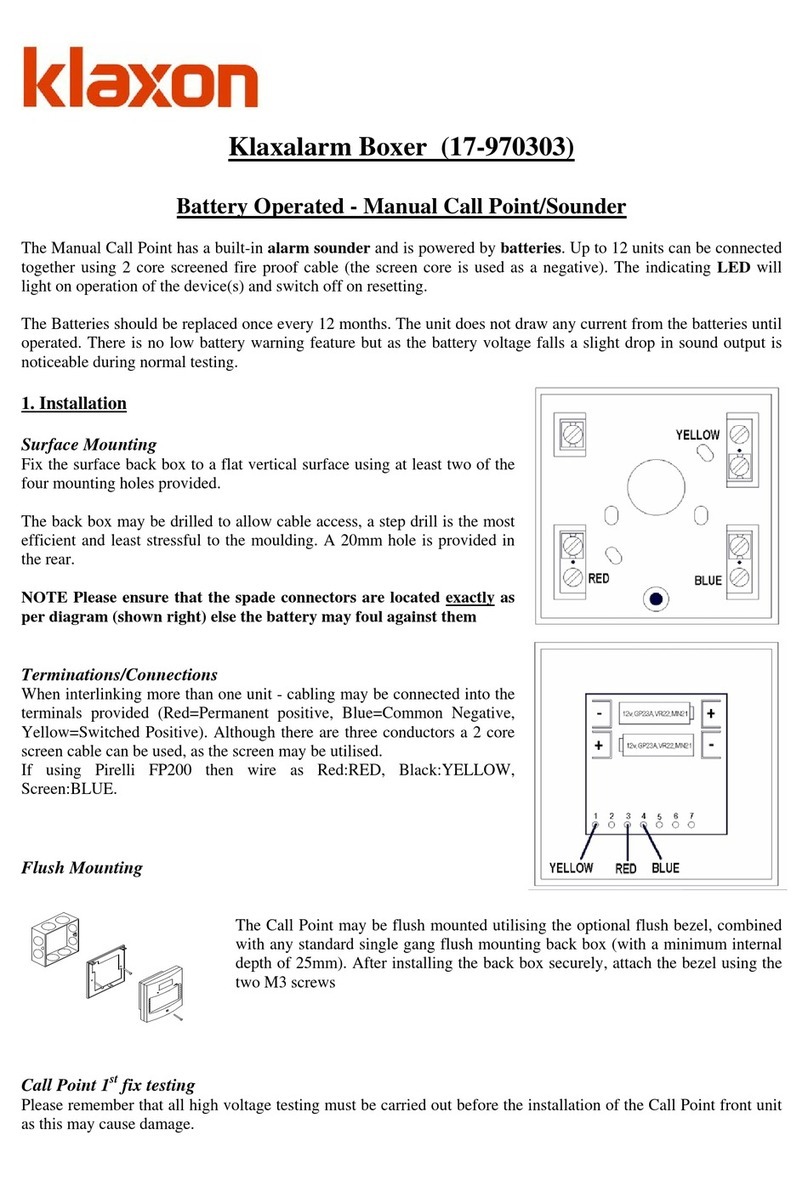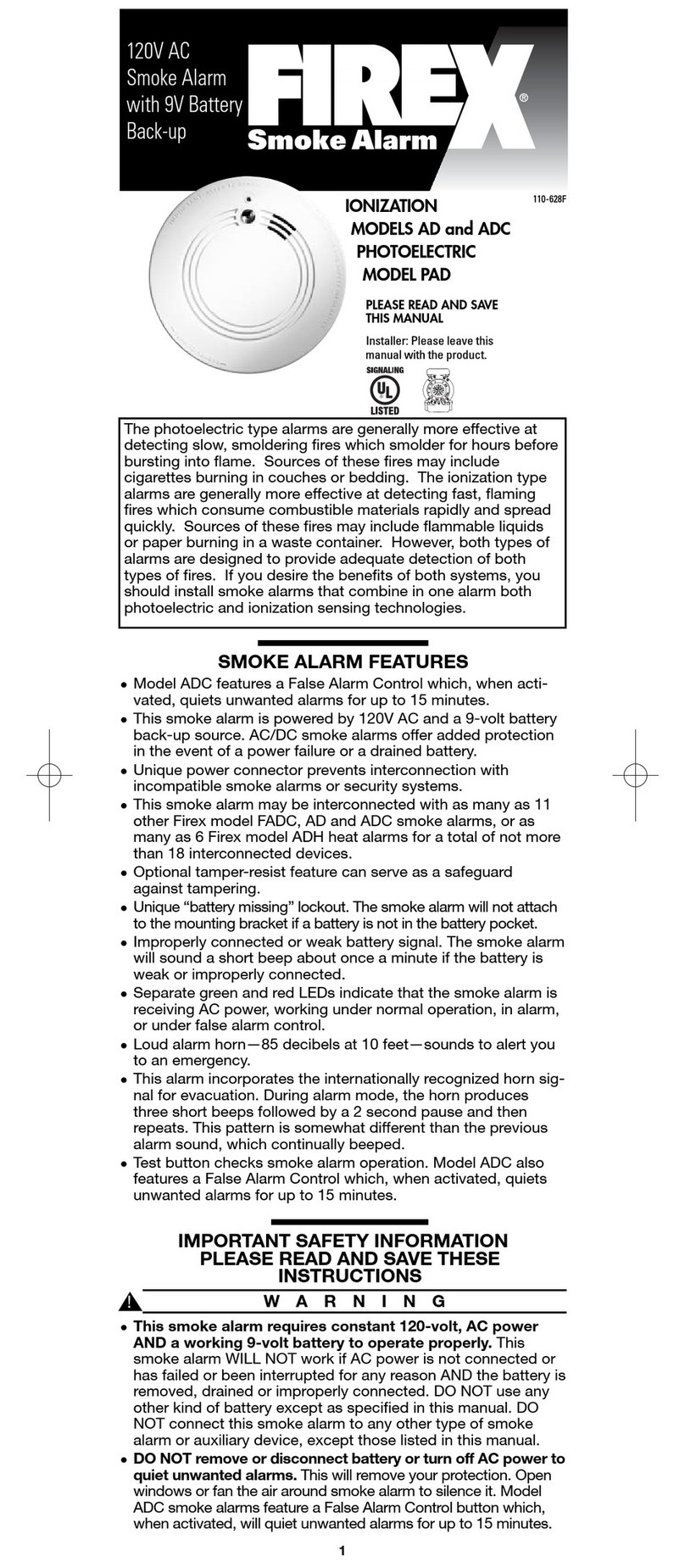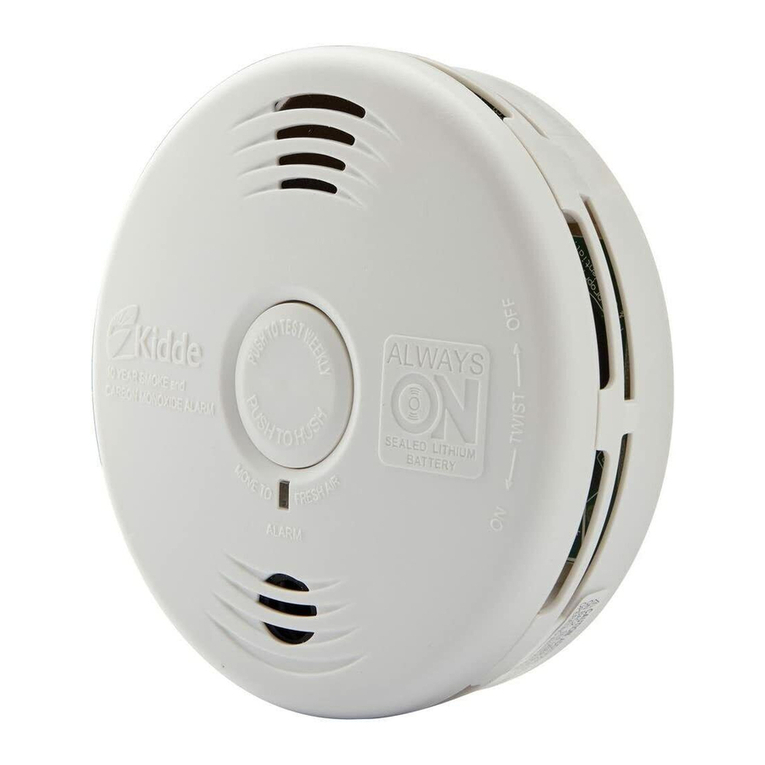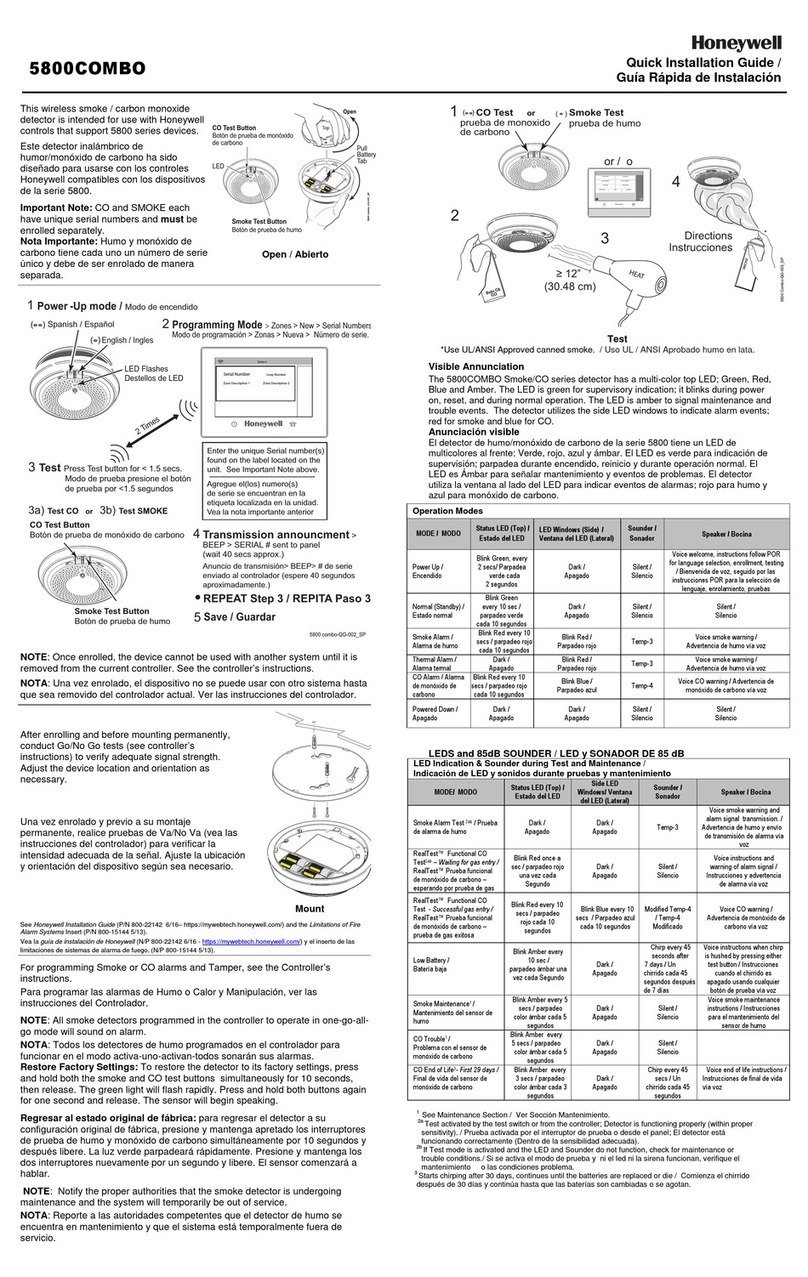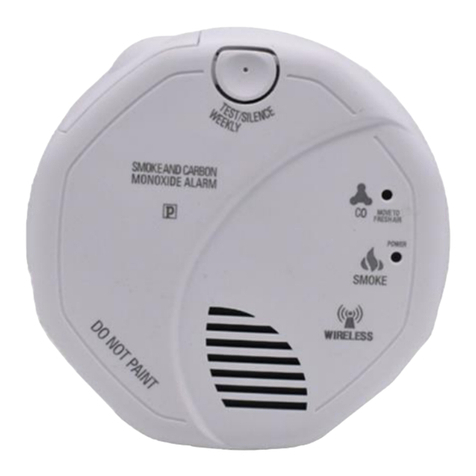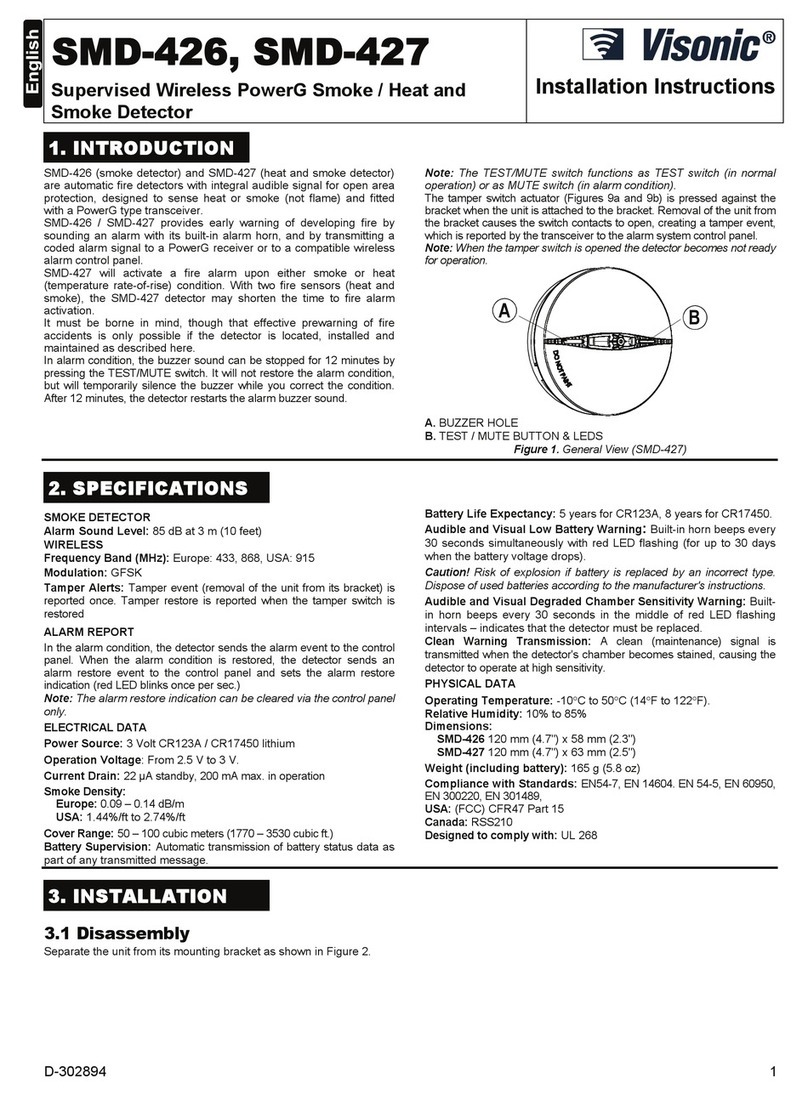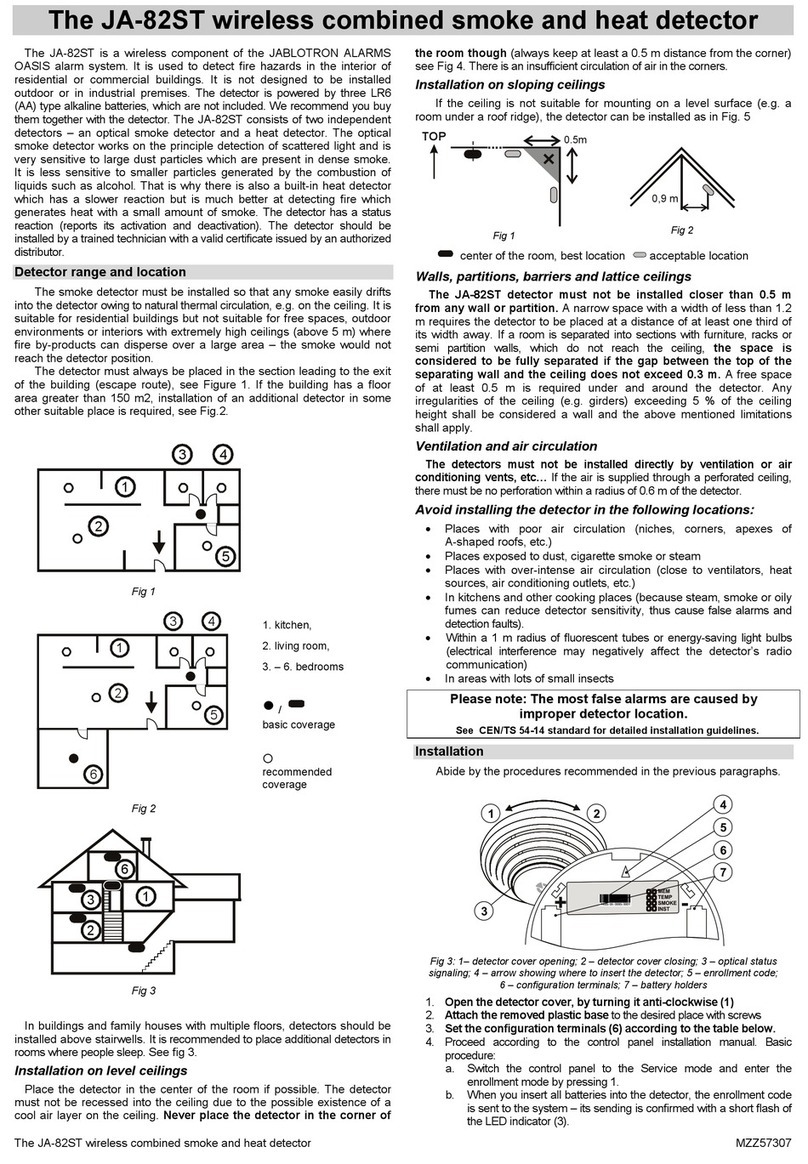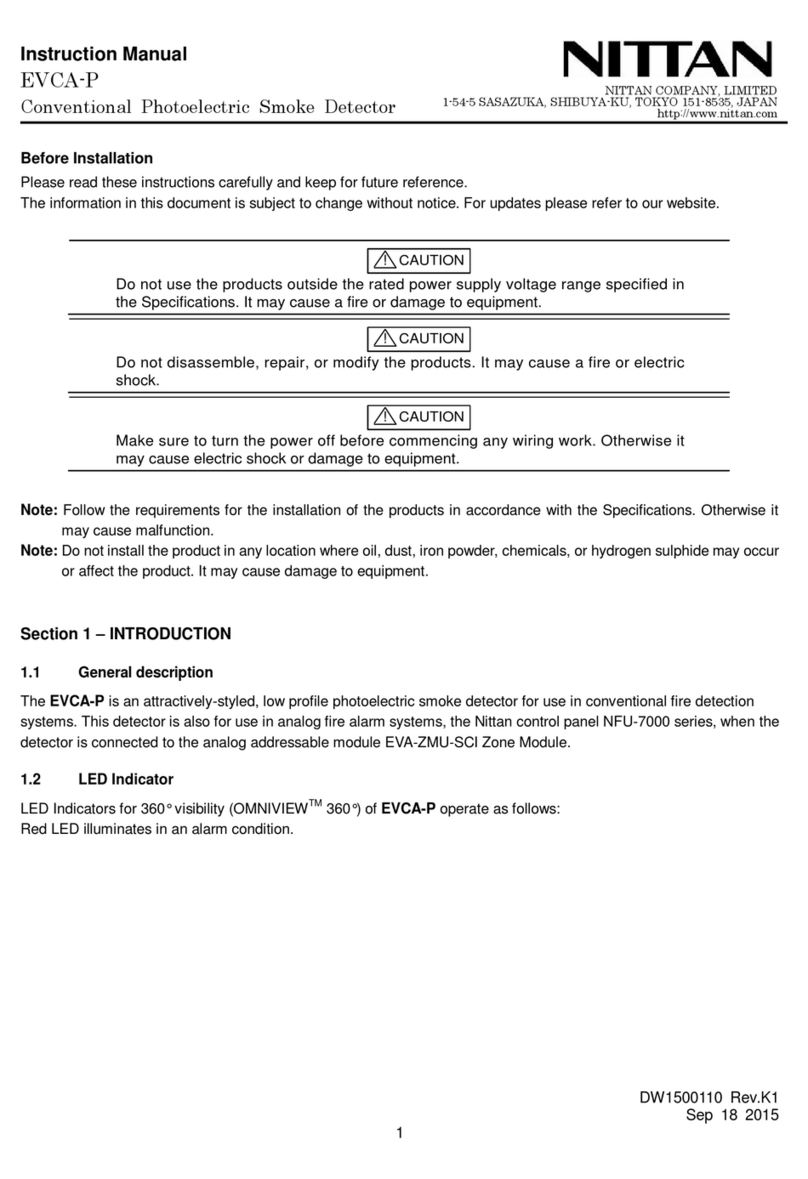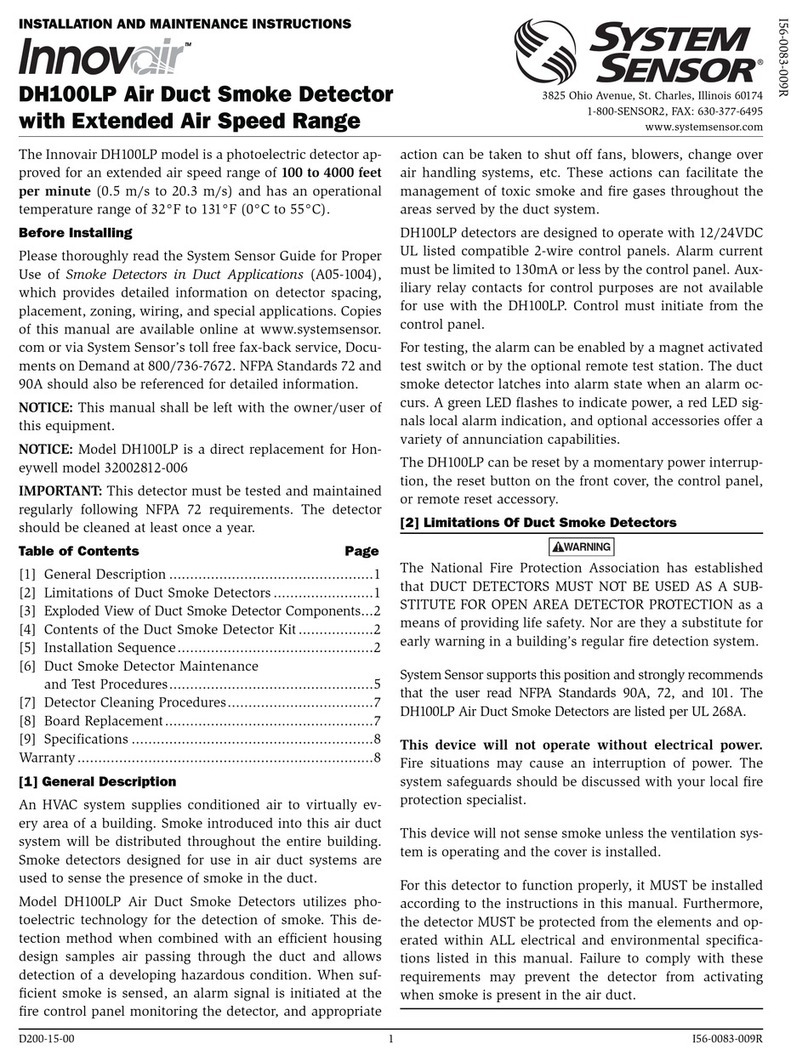Metasys 2251J User manual

Fire Initiating Devices and Notification Appliances Technical Manual 408
Intelligent Products Section
Technical Bulletin
Issue Date 1095
© 1995 Johnson Controls, Inc. 1
Code No. LIT-408065
Introduction Page 3
●
General Description 4
Installation Procedures 7
●
General Information 7
●
Spacing 7
●
Wiring Installation Guidelines 7
●
Installation 8
●
Tamper-Proof Feature 9
Testing and Maintenance Procedures 11
●
Testing 11
●
Maintenance 14
●
Limitations 16
2251J Plug-In Low Profile
Intelligent Photoelectronic Smoke Detector

2 Intelligent Products—2251J Plug-In Low Profile Intelligent Photoelectronic Smoke Detector

Intelligent Products—2251J Plug-In Low Profile Intelligent Photoelectronic Smoke Detector 3
Introduction
This document contains important information about installing,
maintaining, testing, and operating the Johnson Controls 2251J intelligent
photoelectronic detector. If you install this detector for someone else to
use, leave a copy of this document with the user.
Before you install any 2251J intelligent photoelectronic detectors, read
and be familiar with:
●the control panel system installation manual
●the requirements of the authority having jurisdiction
●National Fire Protection Association (NFPA) 72-National Fire
Alarm Code
●System Sensor Guide for Proper Use of System Smoke Detectors
Technical Bulletin in the Fire Initiating and Notification Appliances
Devices Manual (FAN 408), which provides detailed information on
detector spacing, placement, zoning, wiring, and special applications
●or, for non-United States installations, applicable codes and standards
specific to country and locality of installation
Failure to follow these directions may result in failure of this device to
report an alarm or trouble condition or respond properly to an alarm
condition. Johnson Controls is not responsible for devices that have been
improperly installed, tested, or maintained by others.
As is the case with all installations under NFPA, Underwriters
Laboratories, Inc. (UL), Underwriters Laboratories of Canada (ULC), or
Canadian Electrical Code classification, final written approval of
permissible operation and configuration rests with the authority having
jurisdiction.

4 Intelligent Products—2251J Plug-In Low Profile Intelligent Photoelectronic Smoke Detector
Model 2251J is a plug-in smoke detector that combines a photoelectronic
sensing chamber with addressable-analog communications. The detector
transmits an analog representation of smoke density over a communication
Signaling Line Circuit (SLC) to a fire alarm control panel.
This detector is designed to provide open area protection, and to be used
with compatible control panels only.
!
CAUTION: Equipment hazard. Do not use in potentially
explosive atmospheres. Do not leave unused
wires exposed.
Rotary decade switches are provided on the back of the detector for setting
the detector’s SLC address.
The detector has two Light Emitting Diodes (LEDs) that provide visual
indication of the detector’s status. In normal mode, the LEDs blink every
time the detector is polled by the control panel when the blink feature is
enabled in the system programming of the control panel. When the
detector is in alarm, the LEDs are latched into a constant On condition.
When the system and the detector is reset after an alarm, the LEDs will
return to the normal blink mode if programmed.
Note that only five detectors on any one SLC can latch on the detector
LEDs in the alarm condition. However, if the detectors are designed to
limit the current drawn from the SLC, the system can be programmed to
latch on more LEDs when additional detectors are in alarm. This mode is
needed if a relay or sounder detector mounting base is used when
controlling an auxiliary function such as equipment control or local
signaling, or if a duct smoke detector relay controls a HVAC fan.
Remote LED annunciation capability is available as an optional accessory
(RA400Z).
The 2251J detector is designed to provide open area protection. It requires
compatible addressable communications to function properly. Connect
this detector to UL Listed-compatible control panels only.
General
Description

Intelligent Products—2251J Plug-In Low Profile Intelligent Photoelectronic Smoke Detector 5
Table 1: Specifications Summary
Specifications
Operating Voltage Range 15 to 28 Volts
Maximum Standby Current 230
µ
A @ 24 VDC (no communication)
Maximum Average Standby Current 255
µ
A (one communication every
five seconds with LED blink enabled)
Maximum Alarm Current (LED on) 6.5 mA @ 24 VDC
Operating Humidity Range 10% to 93% Relative Humidity,
Non-condensing
Operating Temperature Range -10 to 60°C (14 to 140°F)
Do not install in locations where normal
ambient temperature range extends beyond
0 to 49°C (32 to 120°F).
Height 1.7 in. (43 mm) in B210LPJ Base
Diameter 6.2 in. (155 mm) in B210LPJ Base
4.1 in. (104 mm) in B501 Base
Weight 3.6 oz (102 g)
Air Velocity Range 0 to 4000 feet per minute
Accessories Part Number
Flangeless Adapter Base B501J
Flanged Adapter Base B210LPJ
Detector Base with Control Relay B224RBJ
Isolator Detector Base B224BIJ
Retrofit Replacement Flange for
B501BJ Base F110
Remote LED Annunciator RA400Z
Detector Sensitivity Test Tool MOD400R
Surface Mounting Kit SMK400
Test Magnet M02-04-01
Detector Removal Tool XR-2
Extension Pole for XR-2 XP-4
In order to assure proper operation this product should be applied as
specified in the applicable NFPA codes and in compliance with its
UL listing.
!
CAUTION: Personal injury hazard. This device will not
operate without electrical power. Frequently, fire
situations may cause an interruption of power. The
system safeguards should be discussed with your local
fire protections specialist.

6 Intelligent Products—2251J Plug-In Low Profile Intelligent Photoelectronic Smoke Detector
Johnson Controls smoke detectors are marked with a compatibility
identifier located as the last digit of the five digit code stamped on the base
of the product. Connect detectors only to compatible control units as
indicated in Johnson Controls compatibility chart, which contains a list of
UL Listed control units and detectors. See the Device Compatibility
Technical Bulletin located in the Fire Management Accessories Manual
(FAN 445).

Intelligent Products—2251J Plug-In Low Profile Intelligent Photoelectronic Smoke Detector 7
Installation Procedures
This section contains installation information for Johnson Controls 2251J
intelligent photoelectronic detectors. Instructions are given for spacing the
detector, and basic wiring information is provided.
The National Fire Protection Association (NFPA)-72-National Fire Alarm
Code defines the spacing requirements for smoke detectors. Typically,
this is 30 foot centers for mounting (maximum of 21 foot radius of each
detector) when the detectors are installed on a smooth ceiling no higher
than 10 feet. Room configuration and operating environment may require
a reduction in the standard maximum 900 square foot coverage for
each detector.
All wiring must be installed in compliance with all applicable local codes,
ordinances, and any special requirements of the authority having
jurisdiction. Proper wire gauges should be used. The installation wires
should be color-coded to limit wiring mistakes and ease system
troubleshooting. Improper connections will prevent a system from
responding properly in the event of a fire.
Refer to the selected plug-in detector mounting base document located in
the Fire Initiating Devices and Notification Appliances Technical Manual
(FAN 408) for installation and wiring instructions.
General
Information
Spacing
Wiring
Installation
Guidelines

8 Intelligent Products—2251J Plug-In Low Profile Intelligent Photoelectronic Smoke Detector
!
WARNING: Equipment hazard. Remove power from the loop
before installing detectors.
To install detectors:
1. Wire the detector base (supplied separately) per the wiring diagram
provided in the detector base technical bulletin.
2. Set the detector to a desired SLC address on the detector rotary
switches (Figure 1), and then write the address on the label on the
base. Set the detector address by:
●rotating the right dial so that the arrow points to the address
unit digit
●rotating the left dial so that the arrow points to the address
decade digit
3. Install the detector into the detector base.
4. Turn the detector clockwise until it drops into place.
5. Continue turning the detector clockwise to lock it in place.
6. Enable the tamper-proof feature. For instructions see the
Tamper-Proof Feature section of this technical bulletin.
7. After all detectors have been installed, apply power to the SLC or
control unit.
8. Remove the detector dust cover if the operating environment is free of
excessive dust as is typically encountered during construction.
9. Test the detector by following the procedure in the Testing section of
this technical bulletin.
testmag3
Figure 1: Rotary Decade Address Switches
Dust covers can be used to help limit dust entry to the detector, but they
are not a substitute for removing the detector during building construction.
If detectors are mounted in a construction area, with or without the dust
cover in place, each detector should be thoroughly cleaned, inspected, and
tested after construction is complete. Remove any dust covers before
placing system in service.
Installation
Limiting Dust
Exposure

Intelligent Products—2251J Plug-In Low Profile Intelligent Photoelectronic Smoke Detector 9
This detector includes a tamper-proof feature that prevents removal of the
detector without the use of a tool.
To make the detector tamper-proof:
1. Break off the smaller tab at the scribed line on the tamper proof tab on
the detector mounting bracket.
2. Install the detector.
tm prprf
Plastic Lever
Break tab at
dotted line b
y
twistin
g
toward
center of base.
Figure 2: Activating the Tamper-Proof Feature
To remove the detector from the bracket once it has been made
tamper-proof:
1. Use a pocket screwdriver, or similar tool, and depress the
tamper-proof tab located in the slot on the mounting bracket.
2. Turn the detector counterclockwise until it separates from the base.
See the applicable detector base data for the location of the tamper-proof
break-off tab and the location of the tool insertion point.
remdetct
Use sm all-bladed
screwdriver to
push plastic lever
in direction of arrow.
Figure 3: Removing the Detector Head from the Base
The tamper-proof feature may be defeated by breaking and removing
the plastic lever from the base. However, this prevents using the
feature again.
Tamper-Proof
Feature

10 Intelligent Products—2251J Plug-In Low Profile Intelligent Photoelectronic Smoke Detector

Intelligent Products—2251J Plug-In Low Profile Intelligent Photoelectronic Smoke Detector 11
Testing and Maintenance
Procedures
All detectors must be tested after installation and following periodic
maintenance. Testing methods must satisfy the authority having
jurisdiction. Detectors offer maximum performance when they are tested
and maintained in compliance with NFPA-72-National Fire Alarm Code.
Before testing, notify the proper authorities that the system is undergoing
maintenance and will be temporarily out of service. Disable the system to
prevent unwanted alarms.
After a detector is set into alarm by one of the following test methods and
the alarm activating device is removed from the detector, the system
should be reset at the control panel before testing any additional detectors.
Upon completion of maintenance and any subsequent testing, enable any
system functions previously disabled for maintenance and notify the
authorities that the system has been returned to normal service.
Before you check each detector:
●Check and make sure the LEDs blink.
If they do not blink, and LEDs on other detectors and/or modules on the
same SLC blink:
●Check the connection between the SLC and the detector.
●Check the data base to make sure the detector is programmed
correctly.
●If the LEDs on the detector still do not blink, return the detector to
Johnson Controls for servicing.
●If the LEDs on the other detectors and/or modules do not blink, check
the SLC connections at the control panel.
The sensitivity and function of each detector must be tested after the initial
installation and periodically thereafter. Refer to the NFPA-72-National
Fire Alarm Code for the required frequency. Check with your local
authority for the requirements in your area.
Testing
Individual
Detector Tests

12 Intelligent Products—2251J Plug-In Low Profile Intelligent Photoelectronic Smoke Detector
Functional: Magnet Test (M02-04-01)
This detector can be functionally tested with a test magnet. The test
magnet electronically simulates smoke in the sensing chamber, and tests
the detector electronics and connections to the control panel.
1. Hold the test magnet in the magnet test area (Figure 4).
2. Both LEDs should latch on within 30 seconds indicating an alarm.
3. The control panel should register an alarm from the detector.
Painted
Surface
testswc7
LED 1
Test Module
Socket
LED 2
Test
Magnet
Test Ma
g
net
Painted
Surface
D
o
N
o
t
P
a
i
n
t
Figure 4: Test Magnet Positioning
Sensitivity: Test Module (MOD400R or MOD400)
A sensitivity test module socket (Figure 4) is provided for checking the
detector’s sensitivity with the MOD400R or MOD400 test module
(supplied separately). The test module is used with a digital or analog
voltmeter to check the detector sensitivity. An acceptable voltage range is
stamped on the back of the detector. Test the detector as described in the
test module manual.
If the detector’s sensitivity limits or the MOD400 limits do not appear on
the back of the detector, the MOD400 is not suitable for field sensitivity
testing of that unit.
Testing the 2251J

Intelligent Products—2251J Plug-In Low Profile Intelligent Photoelectronic Smoke Detector 13
Smoke Entry: Aerosol Generator (Gemini 501)
The Gemini model 501 aerosol generator can be used for smoke
entry testing.
1. Set the generator to represent 4%/ft to 5%/ft obscuration as described
in the Gemini 501 manual.
2. Use the bowl-shaped applicator and apply aerosol until the panel
alarms. It should alarm after 30 seconds.
A detector that fails any of these tests should be cleaned as described in
the Maintenance section of this technical bulletin and retested. If the
detector fails after cleaning, it must be replaced and returned for repair.
You can test all of the intelligent detectors programmed in the system by
issuing a command at the control panel.
This test checks:
●if the detectors are communicating with the control panel
●if the detectors are in the proper sensitivity range
●for any detectors that are in alarm
●for any detectors that are reporting a trouble condition
The test can be performed while the system is in normal operation.
The test will not sound any alarms.
Note: Check with the local authority having jurisdiction to determine
whether you must perform the individual tests on each detector or
whether the following test is acceptable in your area.
Refer to the control panel technical manual for detailed information on
testing the intelligent detectors from the control panel.
Control Panel
Test

14 Intelligent Products—2251J Plug-In Low Profile Intelligent Photoelectronic Smoke Detector
Before cleaning, notify the proper authorities that the system is undergoing
maintenance and will be temporarily out of service. Disable the system to
prevent unwanted alarms.
Upon completion of maintenance, and any subsequent testing, enable any
system functions previously disabled for maintenance, and notify the
authorities that the system is back in service.
1. Remove the detector to be cleaned from the system.
2. Remove the detector cover.
3. Use a small standard screwdriver to release each of four cover
removal tabs that hold the cover in place.
4. Vacuum the outside of the screen carefully without removing it.
5. Remove the detector screen.
6. Pull the screen straight away from the sensing chamber until it snaps
out of place. Replacement screens are available (A4176-00).
7. Use a vacuum or clean compressed air to remove dust and debris from
the sensing chamber.
8. Reinstall or replace the sensing chamber screen by sliding the edge
without the tabs over the sensing chamber.
9. Make sure that one of the screen contacts touches the circuit board
contact.
10. Align the arrow on the screen with the arrow on the detector that
points to the sensing chamber.
11. Push the screen over the sensing chamber until it snaps into place.
12. Reinstall the detector cover.
13. Use the test module socket and LEDs to align the cover with the
detector.
14. Snap the cover into place.
15. When all detectors have been cleaned, restore system operation for
testing purposes and test the detectors as described in the Testing
section of this technical bulletin.
Maintenance

Intelligent Products—2251J Plug-In Low Profile Intelligent Photoelectronic Smoke Detector 15
testsw10
Sensor Cover
Cover Removal Tabs
Sensing Chamber
Sensor Screen
Figure 5: Removal of the Cover for Cleaning

16 Intelligent Products—2251J Plug-In Low Profile Intelligent Photoelectronic Smoke Detector
This smoke detector is designed to activate and initiate emergency action,
but will do so only when used in conjunction with other equipment. This
detector is designed for installation in accordance with NFPA Standard
72-National Fire Alarm Code, or equivalent codes and standards
applicable to country of installation.
●Smoke detectors will not work without power. Alternating Current
(AC) or Direct Current (DC) powered smoke detectors will not work
if the power supply is cut off for any reason.
●Smoke detectors will not sense fires that start where smoke does not
reach the detectors. Smoke from fires in chimneys, in walls, on roofs,
or on the other side of closed doors may not reach the smoke detector
and alarm it.
●A detector may not detect a fire developing on another level of a
building. For this reason, detectors should be located on every level
of a building.
●Smoke detectors have sensing limitations. Ionization detectors offer a
broad range fire-sensing capability, but they are better at detecting
fast, flaming fires than slow, smoldering fires. Photoelectronic
detectors sense smoldering fires better than flaming fires. Because
fires develop in different ways, and are often unpredictable in their
growth, neither type of detector is always best, and a given detector
may not always provide warning of a fire. In general, detectors
cannot be expected to provide warnings for fires resulting from
inadequate fire protection practices, violent explosions, escaping gas,
improper storage of flammable liquids like cleaning solvents, other
safety hazards, or arson.
This detector is UL Listed to operate in a maximum air velocity of
3000 ft/min. Air velocity, along with other factors, may affect
detector sensitivity. See the 1993 NFPA 72-National Fire Alarm
Code, Appendix B for information.
●Test your smoke detector system per NFPA 72-National Fire Alarm
Code, or equivalent codes and standards applicable to country of
installation, at least semiannually. Clean and take care of your smoke
detectors regularly. Taking care of the fire detection system you have
installed will measurably reduce your product liability risks.
Limitations
Controls Group FAN 408
507 E. Michigan Street Fire Initiating Devices and Notification Appliances Technical Manual
P.O. Box 423 Printed in U.S.A.
Milwaukee, WI 53201
Table of contents
Other Metasys Smoke Alarm manuals

Metasys
Metasys 1551J User manual
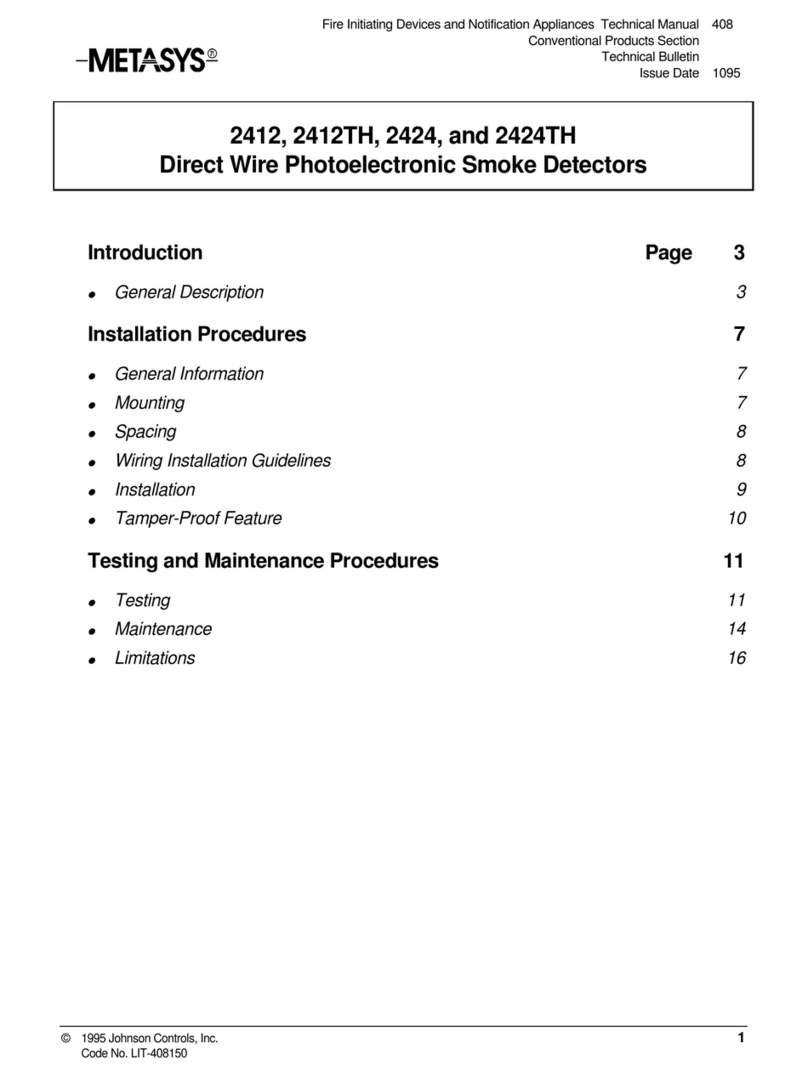
Metasys
Metasys 2412 Series Service manual

Metasys
Metasys 6424 User manual

Metasys
Metasys 2412AT User manual
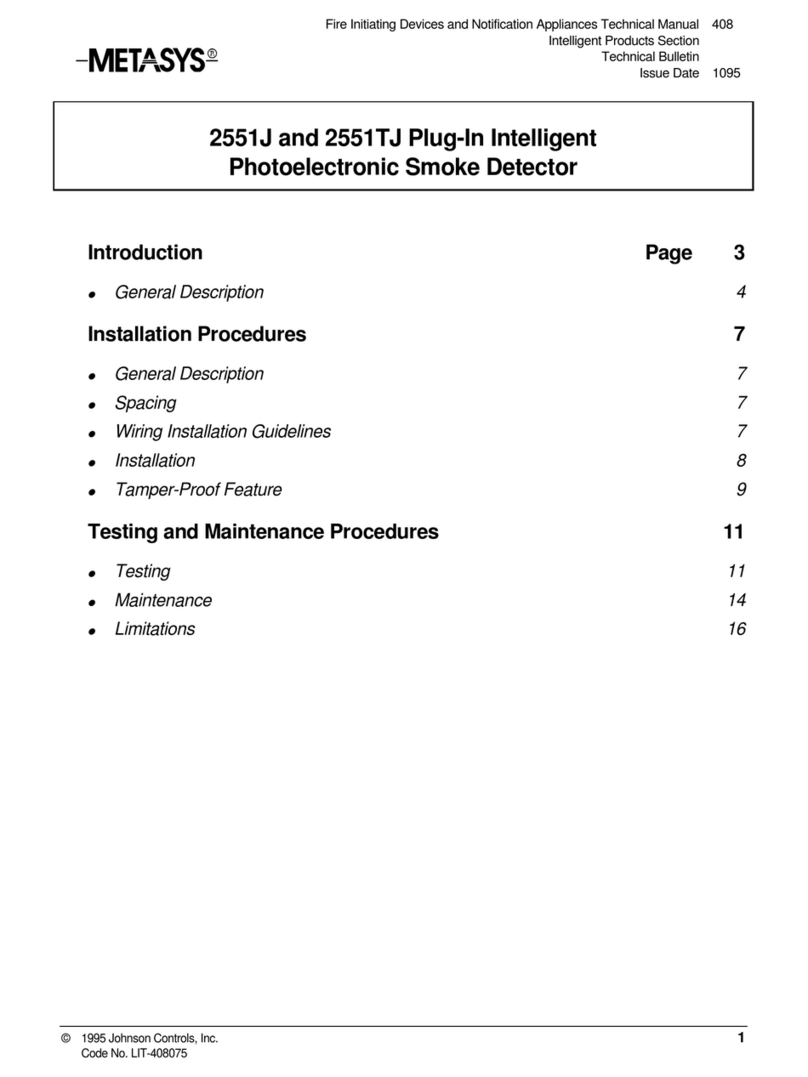
Metasys
Metasys 2551J User manual

Metasys
Metasys 1400 User manual

Metasys
Metasys DH400 User manual
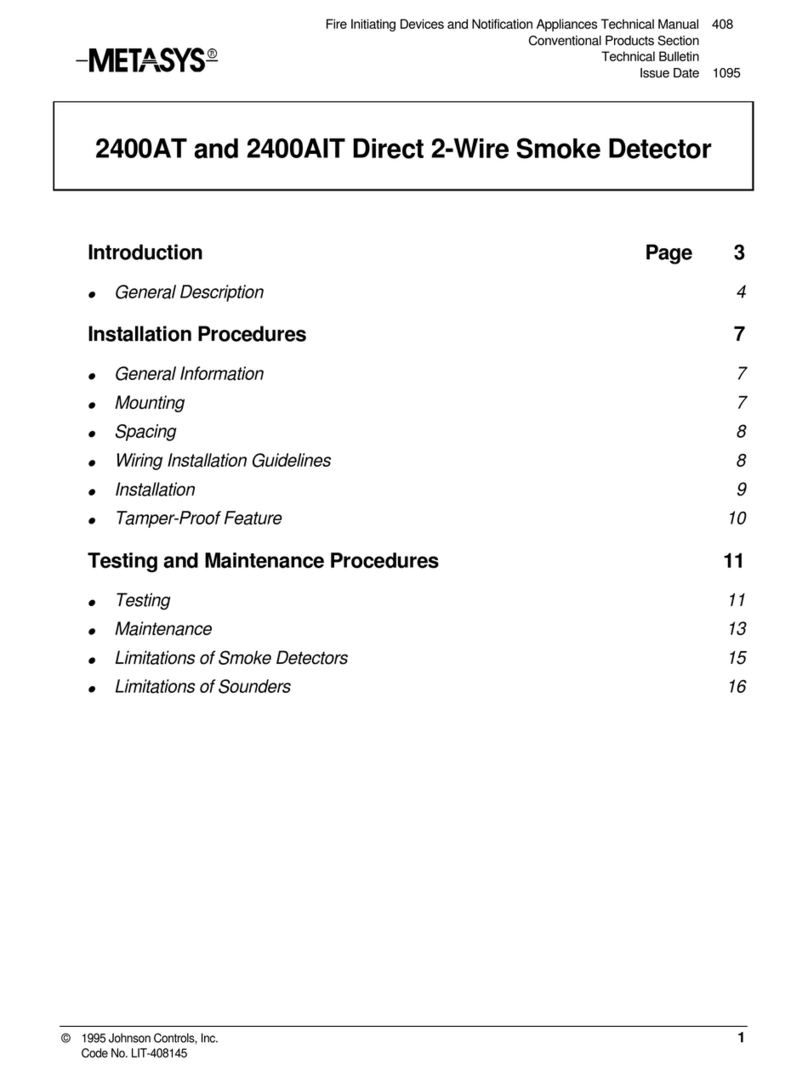
Metasys
Metasys 2400AT Service manual
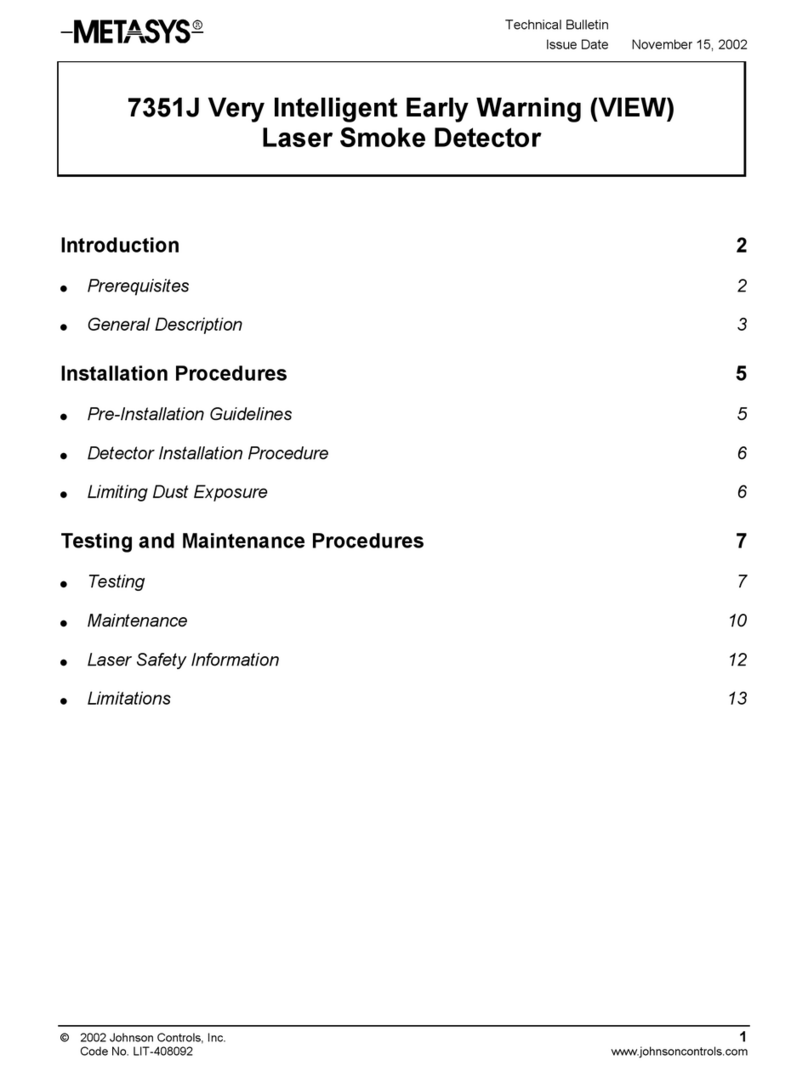
Metasys
Metasys 7351J Service manual

